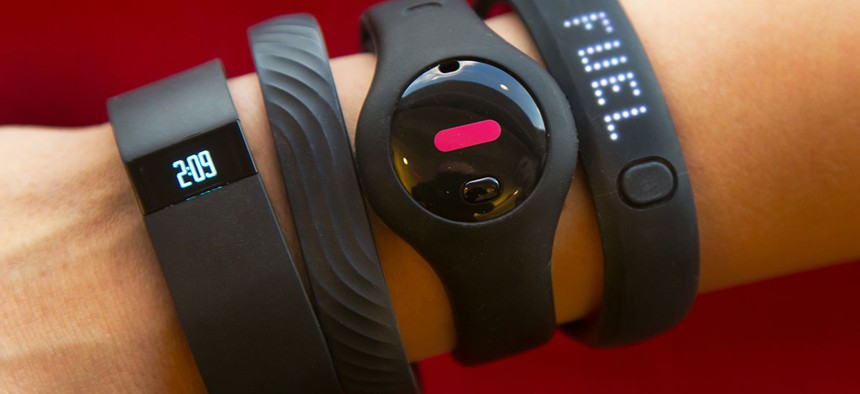Why CDC Wants to Tap Into Wearables

Fitness trackers are just the beginning for the CDC. Richard Drew/AP
The agency is investigating wearable sensors that can alert first responders about radiation and chemical release.
Researchers at the Centers for Disease Control envision a time when a network of sensors can tell first responders what kind of disaster to expect before they reach the scene. Wearable technology, sensors and the Internet of Things are all part of the agency’s futuristic plan for emergency response.
Earlier this year, CDC started collecting public comment on ways sensors could be used to monitor workplace conditions. Nextgov spoke with Gayle DeBord, director of the Center for Direct Reading and Sensor Technology at the National Institute for Occupational Safety and Health within CDC.
This conversation, about the agency’s interest in the Internet of Things, has been edited for length and clarity.
NG: Describe your eventual goal for a more digital emergency response.
GD: There’s new sensors coming out every day. We were wondering how those new sensors might affect how we protect our emergency response workers. There’s wearable sensors, so now we can develop shirts that have different sensors in them that can measure different health parameters like your respiration, your heart rate, your temperature.
There are even sensors out there that you can swallow to measure core temperature, so that way you can look at heat stress. Even just looking at tablet and cellphone apps.
Is there a way to have sensors already located in the field? I was talking to an emergency responders and he said what would be really great for them is if when they get a call to go to a particular building, if there were sensors already in the building that would go off and tell you, is it a radiation problem? Is it a fire? Is it smoke? What’s in the smoke? Is it a chemical release? As they’re going to the site, they would have a better idea what they’re going to experience. It would be quicker for them to figure out how to address that particular call.
NG: How far along are you in implementing this vision?
GD: We’re still in the research phase. The [current] project is really just to come out with a technical report on where we are and what we can envision and then make recommendations on how to proceed forward.
We’re getting ready to conduct some focus groups in probably the next month or so and then we’re going to have a workshop later this summer with subject matter experts to help us form that technical report. We don’t really expect to be done [with the technical report] until the end of 2017. The center is more of a long-term project within the Institute that is expected to continue for however many years NIOSH feels it’s important.
All the sensors are out there like Fitbit, these health sensors. How can we use those to better gauge what’s in the environment? Environmental health has really embraced the sensor world. Environmental health studies can be very expensive because they’re field studies.
If you’re going to need people to take those measurements, it becomes very expensive. Can you develop a backpack that someone can wear, or something they can wear on their waist, that takes better measurement of what’s in their environment?
NG: What’s your first priority application for sensors at the CDC?
GD: I’ll have a better idea in six months. Right now, we’re still in the information-gathering stage. Whether it’s sensor arrays or whether it’s wearable sensors, I think both of them have an important part. I think the wearable sensors are probably easier, because I think people are comfortable with the health fitness trackers.
NG: What challenges might you face when installing sensors?
GD: Buildings are already built. The placement of the sensors are probably going to be the most difficult part of it. How do you design a building to make it inherently safer?
NG: Is CDC planning to work with building engineers or with first responders?
GD: You have to attack it from both ends. The first responders have to say, “This is what we want.” Then, it’s just a matter of putting ... those sensors in and getting the engineers and the construction companies, or whoever’s paying for the building, to get them to add those sensors.
NEXT STORY: Why Commerce Wants Robots to Fix Themselves





